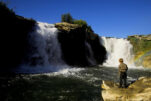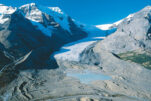Praxis: What makes a sunset so beautiful?
By Medicine Hat News on September 29, 2018.
Summer is officially over for another year as fall did arrive this past weekend. I truly love the changing seasons. There is such diversity and beauty in each and every season. Make sure you get outside and enjoy this seasonal weather before you know what arrives and it is too cold to enjoy the lovely evenings! I had the pleasure of taking in one of the most beautiful sunsets the other evening. Coupled with the changing leaves on the trees, it was a magnificent sight. Of course, this made me think about what makes a sunset so beautiful. Let’s investigate further! *Remember to ask an adult before doing this experiment. Materials – clear drinking glass – water – sheet of white paper – flashlight – skim milk – measuring spoon – tape – sturdy work surface near a wall – spoon Procedure 1. Find a good sturdy work surface near a wall. A table or desk will work well. Make sure that you are allowed to use this area as this experiment could get messy if you spill. 2. Place the clear drinking glass on the table. 3. Directly across from the glass, on the wall, tape the sheet of white paper. 4. Fill the glass approximately 3/4 full of water. 5. Turn on the flashlight and shine it through the glass of water. 6. Observe the colours that shine through onto the sheet of white paper. 7. You may need to darken the room a little bit if you have some difficulty seeing the colours. Just draw the blinds a little bit and see if this helps. 8. Measure out one tablespoon of milk. 9. Stir the milk into the water. 10. Shine the flashlight through the glass of water and milk. 11. Observe what colours shine through onto the white paper now. 12. Examine the glass from all angles and the side. 13. What do you see? 14. Add more milk. Observe. Explanation Did you know that light travels in a straight line until it hits particles? These particles then deflect the light and scatter it. In the air, particles such as dust, ash, ice or even water droplets scatter the light. In this experiment it is when the light hits the milk particles that the light begins to scatter and you see different colours. If you observe the glass from the side, you will see that it looks a bit blue with yellow and orange at the end. As you stir more milk into the mixture, you are increasing the number of particles in the water and the light from the flashlight becomes more scattered. The light farthest from the flashlight turns yellow and orange just like a sunset. The annual Praxis Family Science Olympics is fast approaching. Mark your calendar for Oct. 13 at Medicine Hat College. Keep reading each week for more details! Patty Rooks is senior scientific consultant at PRAXIS, “Connecting Science To The Community.” Contact Praxis at praxis@praxismh.ca, http://www.praxismh.ca, Tweet or follow us @PraxisMedHat, or friend us on Facebook. 32-31




